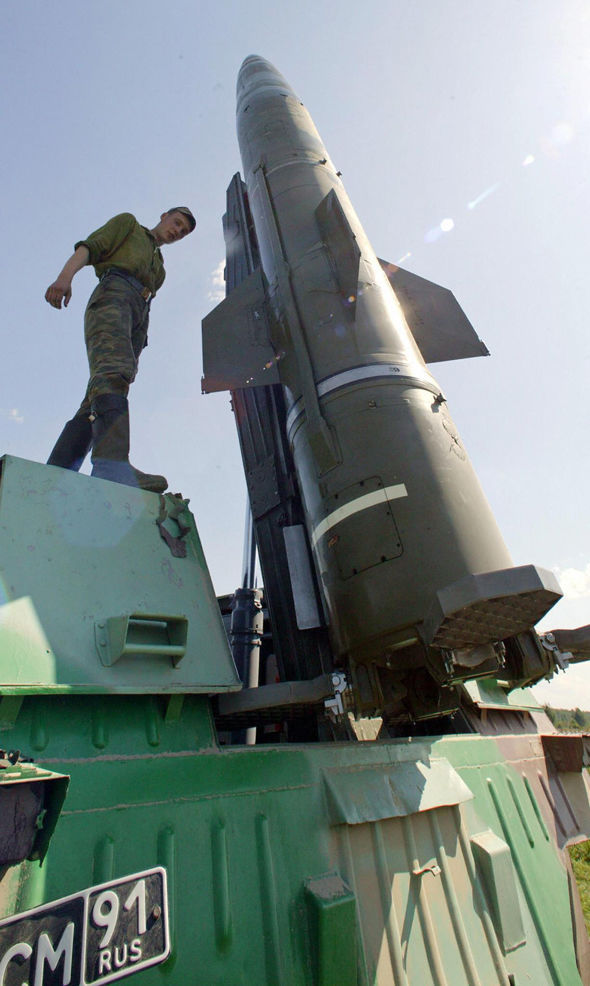
The End of ‘Hide and Seek’: Russian Iskanders Permanently in Kaliningrad
Publication: Eurasia Daily Monitor Volume: 15 Issue: 28
By:

On January 31, Colonel Anatoliy Gorodetskiy, commander of the 152nd Missile Brigade based in Chernyakhovsk (Kaliningrad Oblast), claimed that the infrastructure necessary to host the Iskander-M mobile ballistic missile system (NATO classification SS-26 Stone), with a striking range of 500 kilometres, has been fully prepared to host this type of weaponry on a permanent basis (Polit.ru, January 31). Armed with cruise missiles (Type 9M729), the striking range of this system increases exponentially. Subsequently, on February 5, the head of the State Duma Defence Committee, Vladimir Shamanov, corroborated that Iskander-M complexes had been deployed on the territory of Kaliningrad and will remain there permanently. The top-rank official justified the deployment by citing “the constantly expanding military infrastructure of foreign states near Russian national borders.” He also noted that “this [foreign] infrastructure will become the first target for Russia” in the event that hostilities break out (Vesti.ru, February 5).
The combination of the Iskander-M complexes (meant to fully replace somewhat dated OTR-21 Tochka/Tochka-U systems), the S400 Triumf (SA-21 Growler) anti-aircraft weapon system, as well as the K-300P Bastion-P (SS-C-5 Stooge) and the 3K60 Bal (SSC-6 Sennight) coastal mobile missile complexes, are now forming the first (“outer”) level of the oblast’s Anti-Access/Area-Denial (A2/AD) capabilities (Journal of Slavic Military Studies). The presence of the Pantsir (NATO classification: SA-22 Greyhound) mobile short- to medium-range surface-to-air missile and anti-aircraft artillery weapon systems implies the existence of a double-layered A2/AD “bubble” in the oblast (See EDM, January 30).
Commenting on this news, Dmitry Peskov, press secretary for the Russian president, stated that “the deployment of Iskanders on the territory of Kaliningrad Oblast is a sovereign right of the Russian Federation, and thus should not preoccupy other parties” (Newsru.com, February 6, 2018). At the same time, Peskov refrained from any comments on the fact of the deployment. In his commentary, Aleksey Leonkov, a military expert at the Arsenal Otechestva magazine, related the deployment of Iskander-M complexes in Kaliningrad with the “difficult political milieu in the region.” Namely, he underscored the geopolitical location of Kaliningrad as an ideal place to establish a “military stronghold.” An expert noted that “the constant rotation of troops” on Russia’s Western flank and “the possibility of Russia’s so-called partners to clandestinely transport to Poland the Tomahawks, with a striking range of 2,500 kilometers, which might become an unwanted surprise” fully justifies Russia’s move (Bfm.ru, December 3, 2017). The editor-in-chief of the same magazine, Colonel Viktor Murakhovsky, characterized the fact of the deployment of these complexes as a “serious argument for NATO to start talks with Russia about military de-escalation in Europe” (Expert.ru, February 17).
The jubilant rhetoric of the Russian media and growing concerns among the Baltic States have been complemented by claims by Russian military specialists concerning the Iskander-M complexes. According to Valery Kashin, general designer of Russia’s Machine-Building Design Bureau, not only does the West lack any analogues (among actual and prospective equipment reported by the Western side), but the Iskander-M complexes “are capable of overcoming all currently existing anti-ballistic missile systems” (Rbc.ru, February 11). The military capabilities of Iskander-M complexes have been profoundly boosted after it was declared that a new type of missile, specifically designed for the complex, was created and successfully tested (Minoborony Rossii, October 18, 2017). Indeed, in his latest comment, deputy director of KBM Valery Drobinoga has contended that Iskander-M complexes are now equipped with hypersonic missiles with a maximum speed of Mach 6 (approximately 7,350 kilometers per hour) (Charter97.org, February 11).
In a thorough analysis, Russian experts have underscored key characteristics of the Iskanders that have made this type of weaponry unique (Tvzvezda.ru, February 11). These qualities could be summarized in the following way:
Imperceptibility. This is stipulated by characteristics of missiles that are hypersonic and could be guided at any stage of flight, enabling it to evade currently existing means of anti-missile defense systems.
Unpredictability. Consisting of six independent elements conducted by different technical specialists, Iskander complexes can fire different types of missiles, which is a truly unique quality. Moreover, there are no specific temperature requirements under which the complex can effectively operate. Russian sources argue that the temperature range can vary between –50 and +50 degrees Celsius (which is one of the main “trump cards” of Russian arms and munitions producers), meaning that these complexes might appear and operate virtually everywhere. In addition, in order to fire a shot, it will require one military person and will take a very limited time period.
“Smart home” on wheels. This function is secured by the unified system of command that simultaneously controls various functions (light, heating, air conditioning), indispensable for the personnel. In effect, Russian sources have portrayed the complex to be an analogue of comfortable lodging for eight military personnel. The complex also contains special compartments for arms and munitions, special documentation, studies and means of communication. Particularly important is the fact that the Iskanders are now equipped with so-called “military Internet,” which makes communication and information exchange excessively difficult to meddle with.
If the Russian side has indeed deployed Iskander-M missile complexes on the territory of its westernmost region, this could lead toward multiple repercussions, one of them being further regional destabilization. In effect, Russian talks on potential deployment of Iskander-M missiles in Kaliningrad, initiated at the end of 2007, have turned the Baltic Sea zone into an area of confrontation with Kaliningrad regaining its pre-1991 status. Undoubtedly, Moscow will not step away from this path, which will increase regional tensions (Russiancouncil.ru, February 6). At this juncture, it is interesting to note the reaction of NATO’s Secretary General, Jens Stoltenberg, who warned against a symmetric response by the Alliance. Sentiments of this kind do nothing but convince Moscow that the tactic of pressure is the only rightful remedy in dealing with the West.



